By Jay Jacobs, CFA, Global X ETFs
In July, we exited the Stay-at-Home Economy phase of the COVID-19 pandemic and entered a chapter we call the Re-Opening Economy − a transitional stage that seeks to balance progress toward economic normalcy with limiting the virus’ spread. Many businesses and schools have since carefully welcomed back customers, employees, and students, often instituting new policies requiring social distancing and wearing personal protective equipment (PPE).
However, even for the world’s top medical professionals and policymakers, there exist many unknowns associated with re-opening, and the risk of resurgent outbreaks remains high. Amid this uncertainty, a handful of groundbreaking technologies like Cloud Computing, Genomics, the Internet of Things (IoT), and Telemedicine are playing critical roles in promoting safety while maintaining flexibility. Ultimately, they could prove key to advancing to the final stage of this global crisis: The New Normal Economy.
The Re-Opening Economy: Two Steps Forward, One Step Back
Sandwiched between the two extremes of the largely shut-down Stay-at-Home Economy and a fully opened New Normal Economy, the Re-Opening Economy is an uncertain, transitional phase. Without a widely distributed COVID-19 vaccine, future outbreaks remain a looming threat, while the economic and emotional tolls of the Stay-at-Home Economy create mounting pressure to resume in-person learning and work.
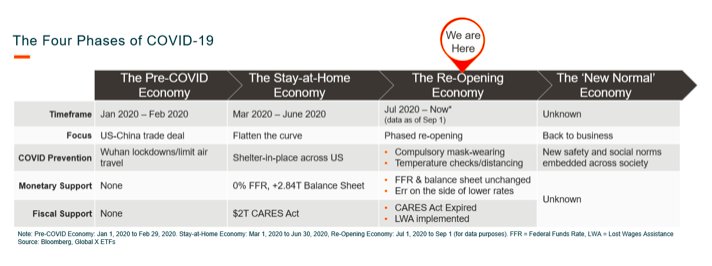
Government officials and business leaders are re-opening in phases, hoping to balance these competing forces by gradually resuming in-person interactions. Supportive policies can include enforcing mandatory mask-wearing, encouraging outdoor dining, reducing office-capacity, and alternating schedules for students’ and employees’ in-person attendance. Over time, these policies can loosen or tighten depending on their success.
Yet despite these efforts to prevent new outbreaks, weddings, college campuses, and Wall Street trading floors were recently responsible for a handful of localized COVID-19 outbreaks. Responses to these spreader-events are often steps backward; employees and students are sent home, while public gatherings are further reined in. Therefore, the Re-Opening Economy is not a linear path to the New Normal Economy. Policies and social norms are changing on the fly, while we adapt and learn from this deadly virus.
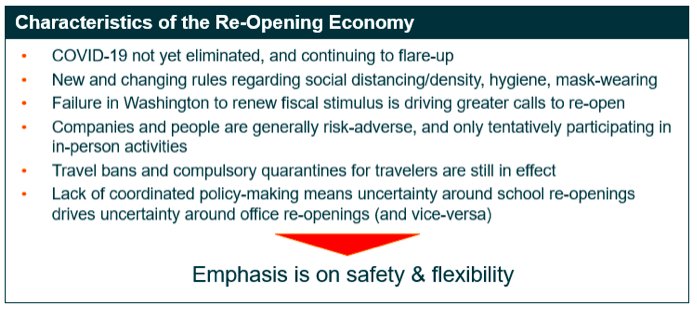
Technologies Promoting Safety & Flexibility Are Critical to Re-Opening
Navigating the tenuous environment requires an approach rooted in two critical goals: 1) Maximizing the safety of stakeholders like employees, students, and customers, and 2) Minimizing the impact future outbreaks may have on business and society by improving flexibility and resilience. We have identified multiple themes that we believe play an essential role in achieving these goals, including Cloud Computing, Genomics, the Internet of Things, and Telemedicine. In our view, the successful and widespread implementation of the technologies could accelerate our progress towards overcoming this pandemic.
Cloud Computing
Cloud Computing broadly describes the digital infrastructure that gives us access to applications, files, and data over the internet. Whereas in the past this functionality was constrained to on-premises desktops and servers, the cloud brings this information to any number of connected devices around the world. Over the past decade, many enterprises already began shifting their IT to cloud-based platforms. But ensuring business continuity amid global shutdowns brought work-from-home to the forefront, solidifying Cloud Computing as an essential pillar of the Stay-at-Home Economy. Many services-based industries, for example, saw successful rapid implementations of cloud-based solutions, resulting in surprising business resilience throughout the pandemic, despite offices widely remaining closed. Employees used videoconferencing to connect with clients, remote server connections to access data and files, internal chat platforms to communicate with team members, and specialized browser-based software to manage business operations
While re-opening efforts suggest the work-from-home trend could be reversing, both employer and employee preferences indicate its likely here to stay. On the enterprise side, many companies simply do not want to take the risk of bringing workers back into their offices before a vaccine is readily available. Major employers like Google, Amazon, and Uber announced that they will not require employees to return to their corporate offices until 2021. And an even greater fundamental shift is underway at firms like Facebook, Twitter, and Square, where employees can now opt to work from home indefinitely.1 For employees, work-from-home affords them greater flexibility, and tellingly, a recent survey found that 40% of employees indicated a preference to work from home for 3+ days a week versus just 14% prior to the pandemic.2
As we face continued re-opening uncertainties and preferences indicate a hesitation to return to the office, work-from-home increasingly appears to be a long-term trend that should benefit companies across the Cloud Computing ecosystem.

Genomics
Genomics is the study of the order, structure, and function of genetic material. It gives us information that can prove valuable in developing diagnostics, treatments, and/or cures for diseases and other afflictions. Over the last two decades, the cost of sequencing a whole human genome dropped by 99.9%, paving the way for a massive collection of genetic data across populations, organisms, and pathogens.3 But it doesn’t end there: more data means more possibilities to analyze and apply it. In recent years, hundreds of genomics-derived drugs and treatments entered clinical trials in the United States. Many of these have the potential to mitigate previously incurable conditions like cancer, assorted heart, eye, lung, and liver-related ailments, and rare genetic diseases.4
Genomic sub-sciences proved essential in lessening the impact of the pandemic at its onset. Modern genomic sequencing and analysis allowed researchers to identify COVID-19 as a novel pathogen in less than 10 days, leading to the prompt development of diagnostics which today inform our mitigation strategies. For comparison, the virus behind 2003’s SARS outbreak took over three months to sequence. Extending the impact of modern sequencing, genomic data has proved invaluable in kickstarting treatment and vaccine development. There are more than 529 COVID-19 treatments and vaccines in development with 35 in clinical trials as of September 29th, 2020. Notably, one of the eight candidates in phase III trials is an RNA-based vaccine. This type of vaccine seeks to use portions of viral genomes to induce immune responses without actually injecting pathogens.5
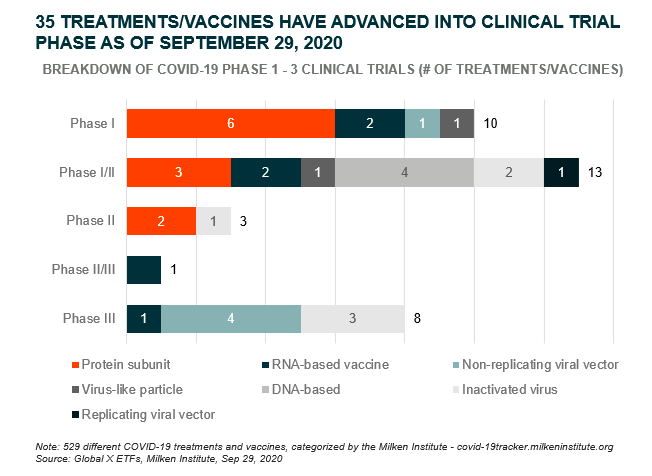
Until there is a vaccine that is effective, widely distributed, and embraced, massive testing and diagnostics will likely remain the predominant mitigation strategy. While country-level efforts for the most part reflected this sentiment from the get-go, private organizations are increasingly embracing their testing procedures as a path to re-opening. Major League Baseball, for example, tests players and staff every two days. The league has conducted well over 140,000 tests since its season began in July, successfully preventing multiple team-specific infections from escalating to a league-wide outbreak.6 Following the success of this approach, companies and universities are likely to institute similar testing policies to protect students, employees, and the communities they reside in. Implementing testing on such a broad scale would likely entail administering millions, if not billions of tests, benefiting genomics and biotech companies with exposure to the diagnostics value chain.
Internet of Things
The internet of things refers to the growing array of internet-connected devices, including smart home appliances, autonomous vehicles, wearables, smart factories, and next-generation infrastructure. Prior to the COVID-19 pandemic, consumers demonstrated a growing preference for smart devices, increasingly buying TVs with internet connections and watches sophisticated enough to supplement their smartphones. But as the pandemic unfolded, technologists realized internet-connected devices could potentially help identify symptoms and enforce social distancing.
Popular wearable health trackers, like the Apple Watch or Fitbit, continually collect heart rate and blood oxygen data from their users. Researchers theorized that measuring this data across thousands of subjects, could uncover population health patterns attributable to COVID-19. Preliminary results from a Fitbit study of 100,000 participants add credence to this idea. In 50% of instances where a positive test followed, Fitbit data detected COVID-19 one day before subjects noticed symptoms.7 The study implies that wearables may help with earlier identification of infection and can therefore recommend formal testing and/or quarantine to prevent the virus from spreading more broadly.
Beyond wearables, other IoT devices can help enforce social distancing and detect symptoms. For example, temperature monitors are increasingly used in airports, schools, and other heavily-trafficked areas to identify those with elevated temperatures. The connected nature of these devices enables data to be transmitted and centralized, offering health officials greater visibility of population-level health. Additionally, proximity sensors can help monitor adherence to social distancing guidelines, while near-field communication chips can play a part in alerting individuals if they encounter infected persons.
Beyond wearables and other sensor-equipped devices, there are a handful of use-cases for internet-connected devices that could prove invaluable to the re-opening process. These include drones and robots that can also help facilitate social distancing and limit person-to-person contact.
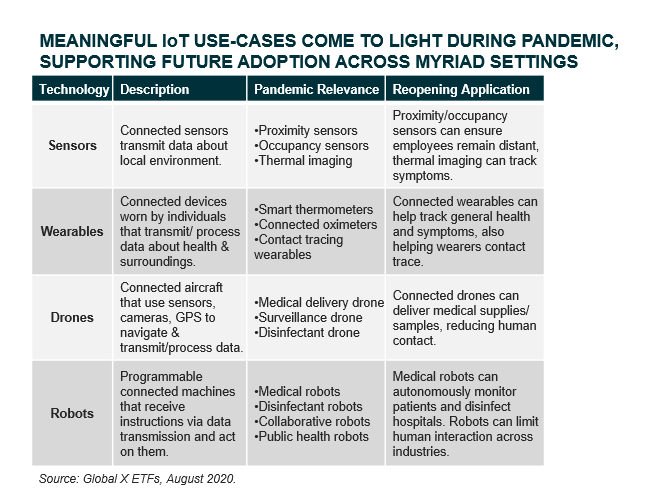
Telemedicine
Telemedicine connects doctors and patients over the internet, enabling virtual consultations and remote monitoring of patients’ health. Prior to COVID-19, these technologies saw limited adoption as deeply engrained stakeholder practices proved difficult to disrupt. Yet as the pandemic unfolded, providers, patients, and payers quickly realized the benefits of telemedicine. By connecting with doctors through videoconferencing services and mobile health applications, patients could avoid the pandemic-related dangers of in-person visits and reduce costs by $19-121 per visit.8 From February to April 2020, telemedicine usage surged more than 30x, with related medical claims soaring from 0.4% to 13%.9
We anticipate telemedicine playing a continued essential role in the Re-Opening Economy given the flexibility and safety it offers. In addition, telemedicine represents just one facet of health care’s digital transformation that should see broader acceleration as health systems seek to improve patient outcomes and improve efficiency.
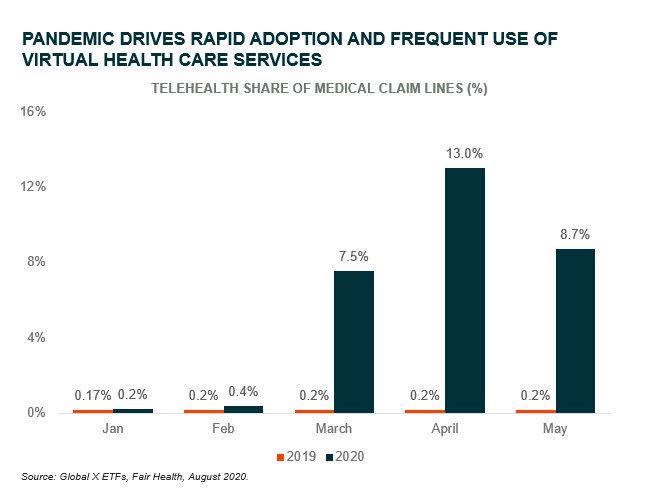
A Path to The New Normal
Though the Re-Opening Economy roughly began in July, the lack of a vaccine and continued flare-ups of COVID-19 around the world suggest that this transitional phase is likely to remain in place for an extended time frame. The new norms and policies introduced to combat the virus will force economies and societies to adapt and may have lasting impacts beyond the current pandemic. Work-from-home could become a standard option for employees. IoT implementation in buildings and public spaces could become a part of standard health and security practices.
Frequent diagnostics and telemedicine could become default approaches to medicine and health care. And while the world will recover, it will not return to the Pre-COVID Economy of yesteryear. Such potential for permanent change and disruption is why we refer to the next phase of our recovery from the COVID-19 pandemic as the “New Normal Economy.” We expect that many of the themes and technologies that enabled the Stay-at-Home Economy, facilitated the Re-Opening Economy, and could feature prominently in the New Normal Economy, will play vital roles in our lives moving forward.
Photo Credit: edward stojakovic via Flickr Creative Commons
FOOTNOTES
1. Employee data from Bloomberg, accessed on 8/31/2020.
2. Iometrics, Global Workplace Analytics, Global Work From Home Experience Survey, 2020.
3. NIH, National Human Genome Research Institute, 2018.
4. NHGI, 2018.
5. Global X ETFs, Milken Institute, Aug 21, 2020
6. Major League Baseball, “Latest MLB COVID-19 Test Results,” Sep 25, 2020.
7. Fitbit, “Early Findings from Fitbit COVID-19 Study Suggest Fitbit Devices Can Identify Signs of Disease at Its Earliest Stages,” Aug 19, 2020.
8. The American Journal of Emergency Medicine, “On-demand synchronous audio video telemedicine visits are cost effective,” Aug 7, 2018.



